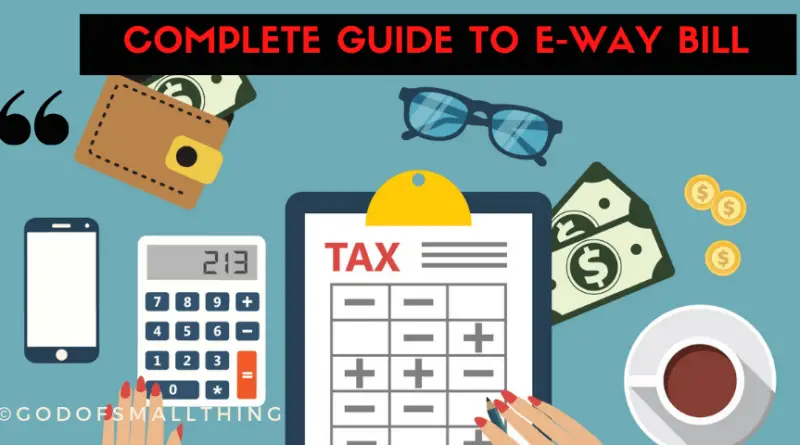Complete Guide to E-Way Bill|Registration|Generation|Activation|FAQ’s
After the new regulations of the government of India. It is mandatory to file tax through the GST portal of the Government of India. However, there are a lot of misconceptions and doubts in the minds of businessmen and taxpayers. Don’t worry by end of the article you will be able to have a clear understanding of E-way Bill and who needs to How to generate eWay Bill, why it is e-way bill is required, how to generate e-way bill and some FAQ’S as well.
Table of contents
- What is E-Way Bill ?
- When to generate e way bill ?
- Who should generate e way bill ?
- Why the e-way bill is required?
- Is E-way bill compulsory & what are the cases where the e-way bill is not required?
- How to generate the e-way bill?
- E way bill registration
- How to activate the e-way bill?
- How to change the username in the e-way bill?
- How to change the password in the e-way bill?
- How to print the e-way bill?
- Can we generate the e-way bill without the GST number?
What is E-Way Bill?
E-Way Bill is an Electronic Way Bill that is generated on the E-Way Bill Portal for the movement of goods. A GST registered person can’t transport goods in a vehicle of goods value more than Rs. 50,000, without an e way bill generated on the concerned website.
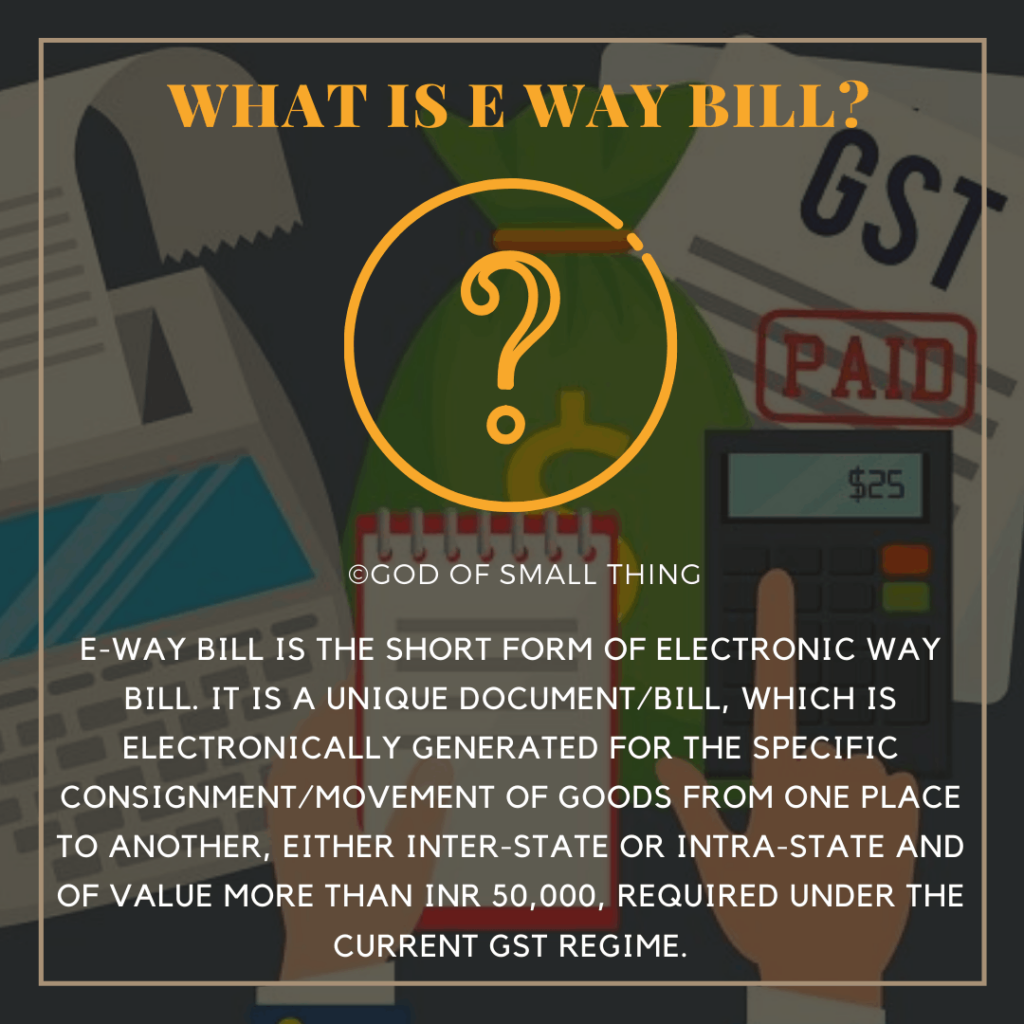
A unique E-way bill Number is generated as the bill is produced. The generated number is available to the manufacturer, the receiver and the transporter. It should be kept in mind that the adoption of the bill was delayed when GST was introduced on first July so that the government, business, and transporters get time to prepare for the final implementation of the e way bill. Apart from this, there were some states including Gujarat having form 402 and listen until the GST e-way gets implemented
When to generate e way bill?
E-Way bill is generated when the movement of goods in a vehicle exceeds the Rs 50,000 amount. The movement of goods will be either about supply or any reason other than supply like a return or inward supply from an unregistered person.
Moreover, for an e way bill, supply is considered perhaps as a payment in the course of business. It is also considered as a payment that may not be in the course of business. The e-Way Bill is generated electronically after completing the GST Form EWB-01.
GST E way Bill format
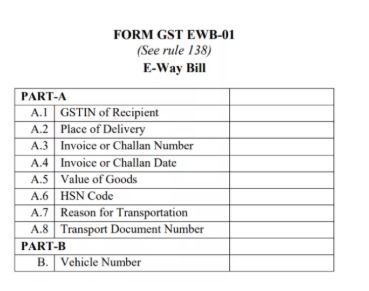
An e way bill consists of GSTIN of the recipient, place of delivery, and, invoice or challan number. It also consists of HSN code, the reason for transportation and transportation document number, and the value of goods.
The E-way bill format is given in rule 138 and is divided in part A and part B. part A contains the details including GSTIN of the recipient, place of delivery, invoice or challan number, the value of goods, HSN code, reason of transportation and transportation document number. Whereas Part B contains vehicle numbers and vehicle-related details.
Who should generate e way bill?
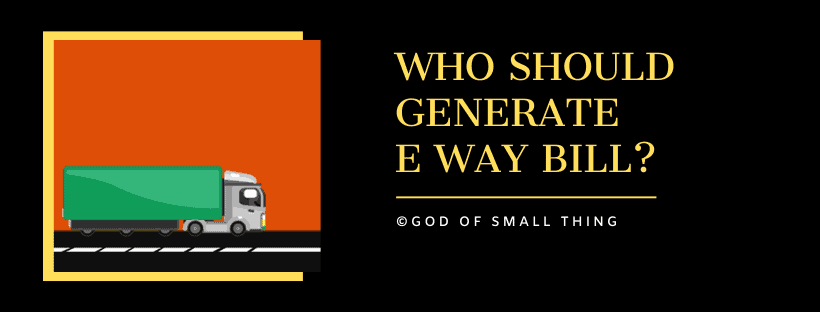
If the movement of goods is more than Rs 50,000, it is assumed that the E-way bill will be produced by a registered individual. Whereas on the other hand, if the value of the goods is less than Rs 50,000, a registered individual or transporter can elect to generate and carry the Eway bill.
Apart from this Unregistered individuals or their haulers may also choose to file an e-way charge. It ensures that both registered and unregistered individuals will generate and register an Eway bill. In the case where an unregistered person makes a delivery to a licensed individual, the recipient will have to ensure that all the compliances are followed as if they were the supplier. It can also be generated through SMS.
Why the e-way bill is required?
Before the bill, the Goods were moving locally between two offices of the same assessee without the state e-way-bill. The goods were detained during transportation by the revenue officer. As soon as the assessee was informed of the non-compliance, assessee raised the e-waybill and submitted it in place of submitting it to the revenue officer.
A typical e-way bill is needed to follow the products from the consignor to consignee throughout their travel. It is created on the e way bill site, electronically. The e-way billing system provides a complaints mechanism for transporters, keeping the condition that a vehicle stays at rest for 30 minutes. Completing Part B of the e way bill is a requirement for the movement of the goods. Except where the distance is less than 50 km within the same state movement between the consignor’s place and the transporter’s place.
Is E-way bill compulsory & what are the cases where the e-way bill is not required?
E-way bill operations are compulsory for the intra-state movement of goods. With effect from 3 June 2018, the e way bill was made compulsory in Delhi. E-way bill operations are compulsory for the intra-state movement of goods for Andaman & Nicobar, Chandigarh, Dadar & Nagar Haveli, Lakshadweep, Maharashtra, Daman & Diu and Manipur with effect from 25 May 2018.
Few Cases in which e-way bill is not required
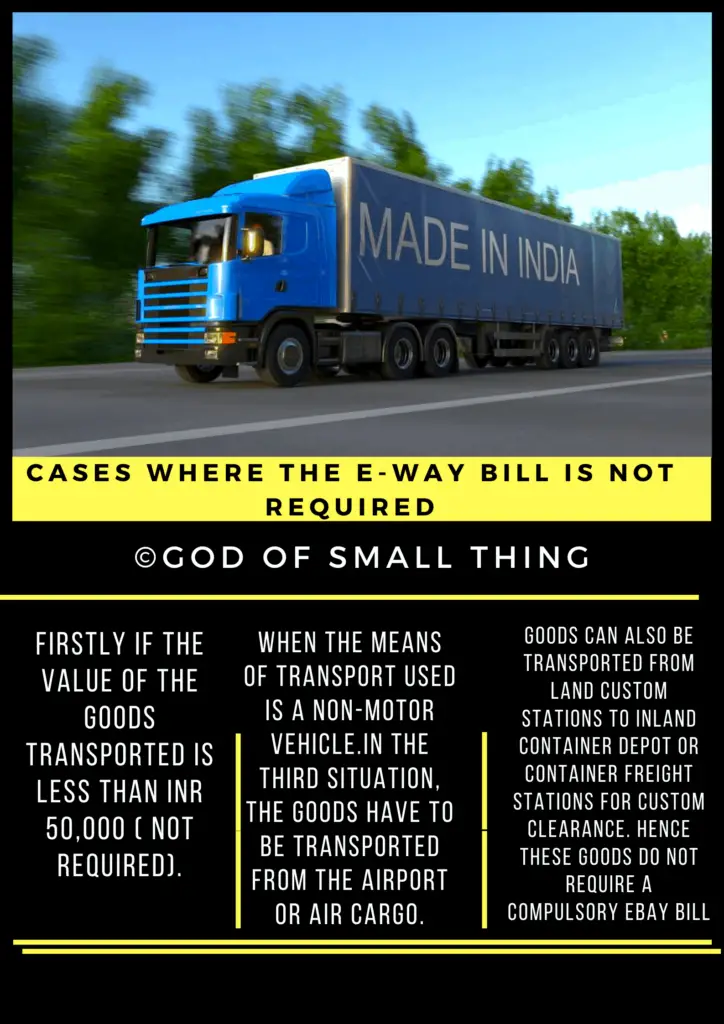
- Firstly If the value of the goods transported is less than INR 50,000 ( not required).
- Secondly when the means of transport used is a non-motor vehicle.
- In the third situation, the goods have to be transported from the airport or air cargo.
- These goods can also be transported from land custom stations to inland container depot or container freight stations for custom clearance. Hence these goods do not require a compulsory eBay bill.
Fourthly if the goods that are being transported within the same state considering a distance of less 10km from the place of business of transporter to the place of business of The consignee.
What happens if Part B is not filled in e way Bill?
Any supplier is transporting goods where the consignment value greater than You require Rs. 50000 to generate and produce this e-way bill. Part B comprises transporter details including the Vehicle number and transporter ID.
The part B of the bill contains transportation details that help in the generation of Eway bills. Transfer of products without an invoice cover and an e-way bill leads to an offense. It imposes a fine of Rs.10,000 or tax claimed, whichever remains higher. Apart from this, they can seize your vehicles and take away your license.
How to generate the e-way bill?
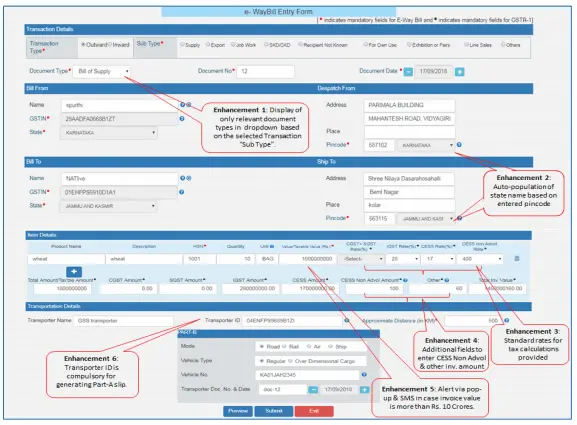
Eway bill can be generated either on the web or by using SMS facility. Not to worry, its simple to generate an E-way bill by following these steps.
- You are supposed to log in on the Eway bill system via the user ID password and capture code to assess the bill.
- After being logged in, on the home screen you will find an option saying generate E-Way bill.
- It will direct you to a screen, asking details about the generation firm. It will ask you about the type of transaction if you are a Supplier offer consignment your transaction will be outward and if You are the recipient your transaction will be inward.
- Apart from this, it will ask you about the document details which you need to provide for the generation of the Eway bill.
- Furthermore, you are supposed to add consignment details like Product name, Description, HSN Code, Quantity, Unit, Value/Taxable value, Tax rates of CGST and SGST or IGST (in %) and the Tax rate of Cess, if any charged (in %).
- After this, the document will ask you about the transporter details, where you need to fill-in transporters ID, name and the vehicle number.
- Finally, click on the submit button and an E-Way bill will be generated, along with the 12 digit E-way Bill number.
How do I check my E-WAY BILL?
It can be registered on the web or by an SMS. fill in the details of the invoice including the transporter ID and vehicle number of the transporter through which the consignment will be transferred. Click the “E-way Bill” option on the e-way bill portal’s home screen, and within that click the “Generate New” site-option. This will open the e-way bill filing form, which includes various fields. Though most sectors are non-compulsory
The E-way form includes Transaction Details, Item Details, and Transporter Details.
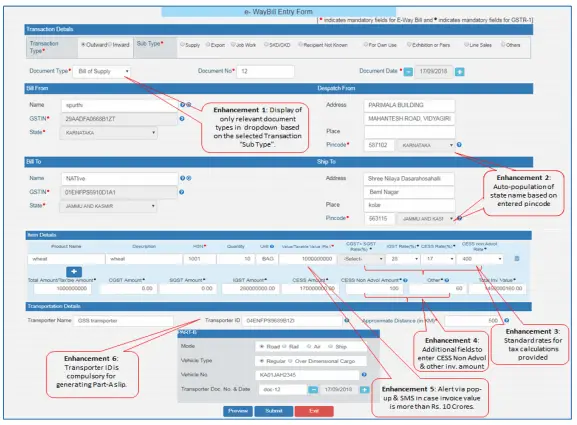
- The process is very simple, first of all, you need to fill the form.
- The Eway Bill will be sent to the transporter’s login account.
- This will enable the transporter to enter the vehicle number in which the goods are to be transported.
- At the same time, the e-way bill portal will validate the values entered, and a corresponding error message will appear in case of any error.
E way bill registration
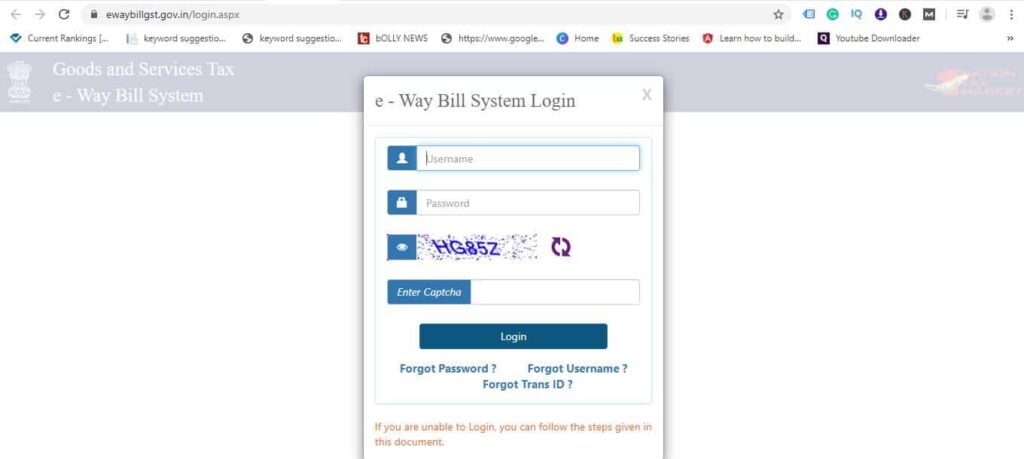
The process of logging in to registered suppliers to create an e-way bill portal is very simple.
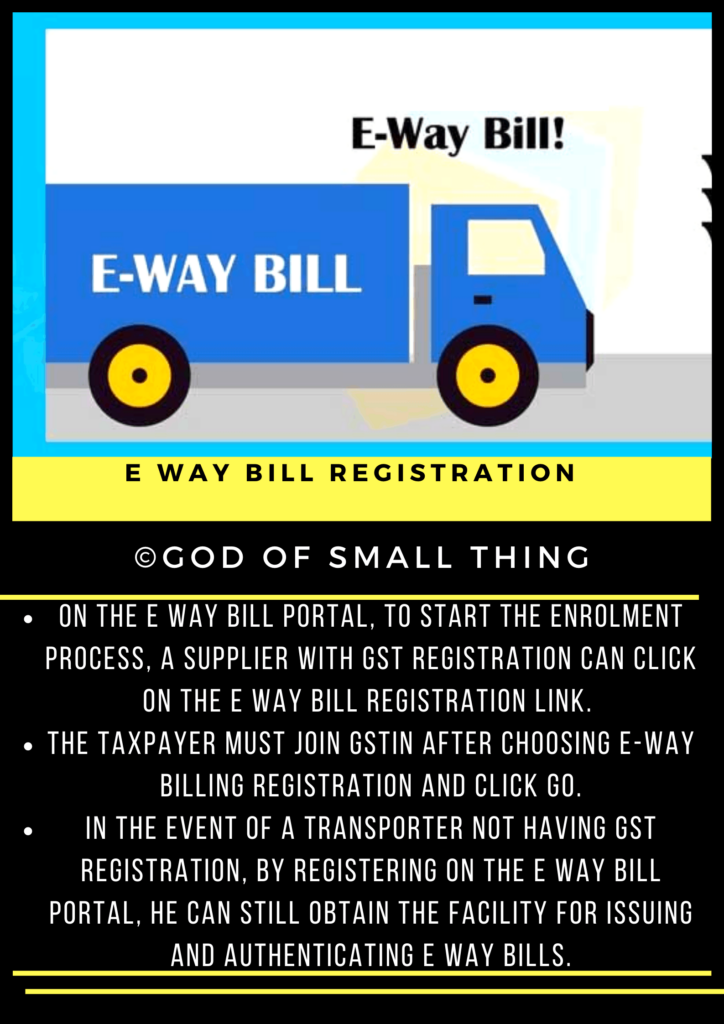
- On the Eway Bill portal, to start the enrolment process, a supplier with GST registration can click on the e way bill registration link.
- The taxpayer must join GSTIN after choosing e-way billing registration and click GO.
- In the event of a transporter not having GST registration, by registering on the e way bill portal, he can still obtain the facility for issuing and authenticating Eway bills.
How to activate the e-way bill?
In the case of a GST registered transporter, the procedure for gaining access to the Eway bill portal is identical to that of an individual with GST registration.
- Firstly Go to the portal on Eway bills.
- Go to the Registration tab and click on Registration of Eway bills
- Generate and submit an OTP and finally
- Generate Password and User ID.
How to change the username in the e-way bill?
- Once you need to login to the E way bill portal, this would generate an option of forgot username.
- Once you press the forget username link, a new pending page will appear asking you for information such as the GST IN, location, main place of business pin code, registered mobile number, email address, and correct captcha code.
- Click on the Go after button to enter all the details.
How to change the password in the e-way bill?
- A tab will appear when you click on User Management on the home screen, in which you need to click on Change Password.
- In doing so, the system will ask you to enter the mobile phone number and legitimize the same via OTP.
- If the OTP is correct then the following window will appear, where you will need to fill in some details including user name, existing password, new password, re-enter new password and then submit and exit. The process is very simple.
How to print the e-way bill?
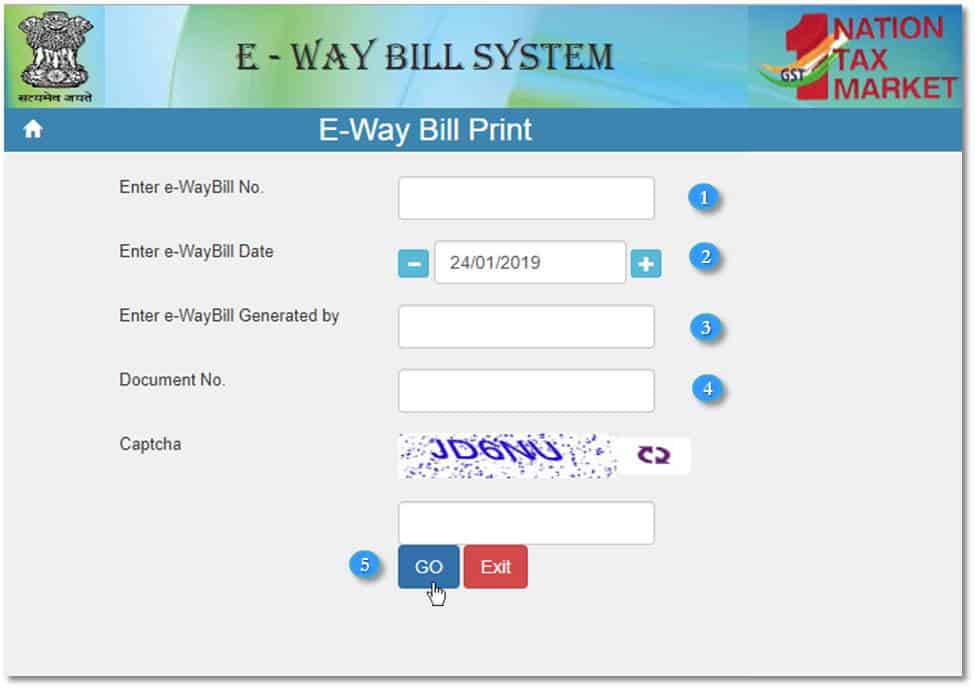
- You can easily perform E-way bill printing by trying to navigate to the home screen and by going through various steps. firstly on the e way bill portal click the “Print EWB” sub-option.
- Apart from this, a screen will entitle you to control and access the relevant e way bill for printing Enter the 12 digit e way bill no., at the end press go.
- The print option will also be available on the bottom right corner of the page.
Can we generate the e-way bill without the GST number?
In the case of a transporter not having GST registration, by registering on the e way bill portal, he can still obtain the facility for issuing and authenticating e-way bills.
Looking for more E-way bill FAQ’S?
Download: FAQs on E-way Bill System – CBIC GST

